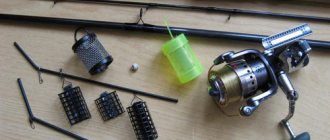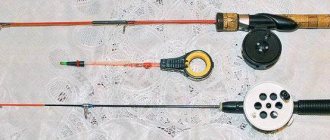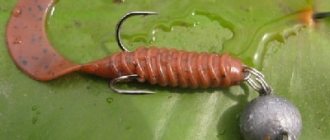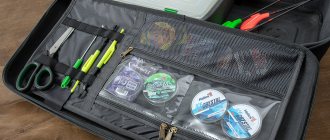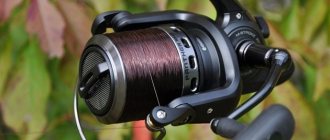First, we’ll learn a little about float fishing, then we’ll look at what kind of fishing line should be used for summer fishing with a float rod.
Float fishing is perhaps the most common fishing method.
If done correctly, this can be extremely effective for catching almost any fish.
Float fishing involves attaching a float to a line that serves several purposes.
this can pause the bait at a given depth.
Thanks to its buoyancy, it can carry a baited hook to otherwise inaccessible areas of water, allowing the float to drift.
The float also serves as a visual indicator of the bite.
Float fishing is easy if you follow these basic steps. Find a suitable location for this method.
Calm waters with little or no current may be a good start.
So keep exploring.
“Read” the water and try to find underwater structures (logs, rocks, weed beds).
Or “transitional” areas (shallow to deep water, muddy bottom to sand/gravel bottom, etc.).
How to choose fishing line
Some fishermen, once accustomed to one type of fishing line, never change their choice again, regardless of surrounding factors and fishing methods, although they understand that the result of successful fishing largely depends on the correct choice.
Before deciding which fishing line to choose for a float rod, you need to understand what the fishing conditions will be like. For example, if you are planning to catch crucian carp near the shore, you should not choose an excessively thick fishing line, since it will scare away the fish more than you will catch it. And, conversely, for fishing at a considerable distance from the shore, if you are going to take a fairly large bream or carp, you should think about equipping your fishing rod with tackle based on a fairly thick fishing line. If you are planning to cast into the reeds, you should not use a fishing line with light shades, and to prevent the float with the tackle from being washed ashore by the breeze, you should consider purchasing a fishing line that can sink.
What leashes and hooks are used in match fishing?
The leashes in match equipment are made from high-quality fishing line with increased breaking characteristics. The diameter of the leads is from 0.01 to 0.14 mm. depending on fishing conditions, biting activity and expected trophy. We can say that the fishing line for leashes should be 0.02 mm thinner than the main one.
As for the length of the leashes in match equipment, in the classic version it is 30-80 cm and is selected, again, based on the fishing conditions: depth, current strength, bottom structure, biting intensity, as well as the type of fish. For crucian carp it is usually 30 cm, for bream – 40-60 cm, and for carp – up to 80 cm.
Regarding long-casting hooks, a strong and sharp hook is an invariable rule. Well, the size of the hooks for the match is selected, as in any other type of fishing, in accordance with the bait used and the intended catch. But we should not forget that a large bait and a large hook always lead to an increase in empty bites. The usual hook size in match fishing is from No. 18 to No. 10.
Primary requirements
The fishing line for match fishing must meet certain requirements:
The line should sink easily
Regular monofilament lies on the water after casting and does not sink. The packaging of match fishing line should have the designation “sinking line”, which means sinking. In order to increase the sinkability, manufacturers cover monofilament with special coatings in two or three layers. Thus, its specific gravity relative to water increases.
But the fishing line shouldn’t be very heavy either. Otherwise, it will sink to the bottom and hooking will become more difficult. And when casting long distances, a sharp hook is very important.
How to make a fishing line sink
You can make the fishing line sink yourself. To do this, wipe it with liquid soap or “Fary”. It is necessary to completely degrease the fishing line. Fatty deposits help keep it floating on the water. Instead of liquid soap, use a special match spray. The effectiveness of the spray is much higher than that of household products.
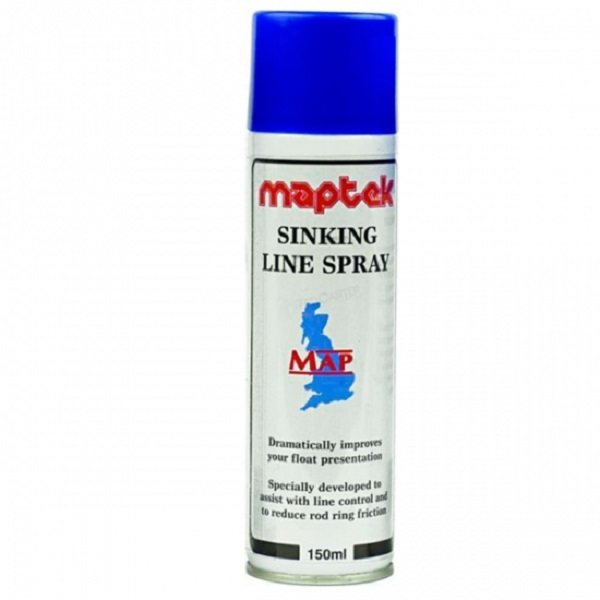
Degreasing spray
Softness and elasticity
This allows for a freer release of the spool and also allows for better winding onto the reel.
Abrasion resistance
The match fishing technique consists of numerous casts. Consequently, the fishing line will constantly experience friction against the reel and guide rings. Therefore, it is very important that the fishing line does not wear out or fray.
Low extensibility
Low stretch will ensure a tight hook.
Lack of "memory"
It should not only be unconscious, but also straighten out in a straight line after casting. Do not curl into rings, but lie flat on the water. If it was twisted, straighten it out. For the same purpose, manufacturers have come up with a special parallel winding on the bobbin, which prevents twisting.
Many people ask the question: how to straighten the fishing line? It turns out that this can be done at home. For example, hang a weight and heat the line with a hairdryer, the rings will go away. Another way to straighten a fishing line is to run it across the hot surface of an iron, kettle or pan. In any case, the heating process promotes straightening.
Dark color
The line should be dark.
Firstly, so that you can mark on it with a marker the distance to which the cast was made. Usually black, dark blue or dark brown. The use of markers is a prerequisite for match fishing. The price of the marker is not important, they are all about the same. Both expensive and cheap markers draw well.
Secondly, the dark color is similar to the color of the bottom, which means the fishing line is hardly noticeable.
Which fishing line to choose
Now let's concentrate on the fishing line itself. Three main varieties prevail in use - monofilament, braided and fluorocarbon, and we will analyze them “piece by piece”.
Monofilament
The most common budget option, proven over the years, with average characteristics. Not so long ago there was neither fluorocarbon nor braid, and our fathers and grandfathers had to be content with only ordinary monofilament made of synthetic polymer, and this polymer was not always of the quality we would like.
Now all monofilament fishing line is of relatively good quality, although it is better to give preference to reputable brands. The advantages of such a fishing line are that it:

- does not get tangled when casting, and if some first-timer happens to perform a poor-quality hook, which results in a “beard” at the end of the rod, then it will be quite easy to untangle,
- has average characteristics in terms of strength and stretching, if desired, it can be sunk, or, conversely, given it buoyancy using special lubricants,
- almost does not wear out (does not wear out from frequent casting) and does not lose elasticity and other qualities for a very long time,
- everyone can afford it.
Although, it also has its disadvantages:
- due to the properties of the material from which it is made, it tends to “gather” under water (especially if the sinker is relatively light), as a result of which most weak bites may go unnoticed,
- if the cast is made over a long distance, the bite may be “delayed” or even remain “behind the scenes” due to the elasticity of the polymer. The longer the line is, the more it will stretch.
Fluorocarbon
A recent development by specialists working for the fishing tackle industry and other gadgets and bells and whistles. In terms of price, it is an intermediate option between regular monofilament fishing line and braided line.
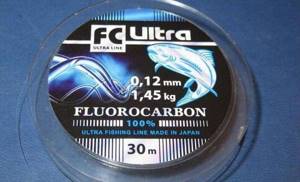
Pros:
- It blends completely with water, especially if you choose the right shade. Even the most “big-eyed” fish will not notice an ordinary transparent thread in the lightest and most transparent water,
- has a huge number of shades, you can choose a fishing line suitable for your pond,
- tangles even less than monofilament,
- It stretches less, so the bite is reflected on the float almost instantly.
But any, even the most brilliant, medal has its downside:
- In terms of strength (thickness/break), fluorocarbon is inferior to other varieties, so when purchasing it is better to take a fishing line thicker (based on monofilament),
- The “memory” of the material is very inconvenient. If the line was on the reel, then after the first cast it will “twist in rings” for a long time.
Wicker
This is the strongest analogue. Coiled from small and ultra-strong nylon fibers, it is more likely to cut through your hands than to be torn by prey. Rods break more often than this line breaks. In addition to strength, its arsenal of advantages includes:
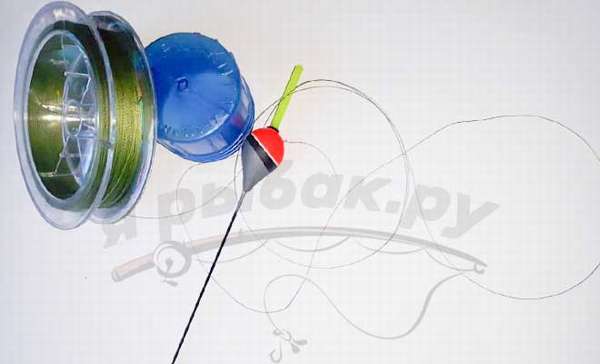
- minimal play, the bite on the float is reflected instantly, just as hooking with such a fishing line is most effective, no “rubber” stretching, contact between the rod and the fish is instantaneous,
- it will be relatively easy to unravel it if you do not tighten excessively tight knots in the created “beard”,
- if desired, it can also be sunk or made floating,
- the material never cakes, so such fishing line will never be collected by the rings from the reel.
Now about the disadvantages, of which there are also plenty:
- after some time (depending on the frequency of casting) this fishing line will become “shaggy”, from friction its fibers begin to bristle at the edges, which greatly affects the camouflage, in the water it becomes three times noticeable,
- in clear water this line is clearly visible even if you choose its lightest version,
- it is the most expensive, and due to its fragility, this is a huge disadvantage in favor of its use.
